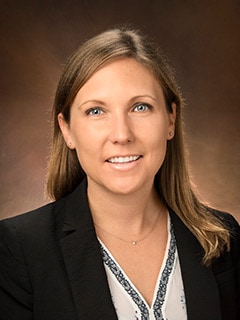Sabrina Gmuca, MD MSCE, is an Assistant Professor of Pediatrics at The University of Pennsylvania, in the United States. Sabrina is an attending Physician and Director at The Center for Amplified Musculoskeletal Pain Syndrome, The Division of Rheumatology at Children’s Hospital of Philadelphia. Additionally, she is a Faculty Member of the Policy Lab and Center for Pediatric Clinical Effectiveness at Children’s Hospital of Philadelphia She has been in the pain field for four years. Melissa has been an IASP member for one year and due to COVID-19 was not able to attend her first IASP World Congress.
How did you get into pain science? Did you always know it was what you wanted to do or did you start somewhere else?
Upon entering my pediatric rheumatology fellowship training at Children’s Hospital of Philadelphia, I’ll be honest, I had no initial desire to become an expert in pediatric chronic non-inflammatory pain syndromes nor a pain science researcher.
During my fellowship training, I completed a Master of Science for Clinical Epidemiology. The thrill of conducting studies that could impact the care of children and teens and constantly learning new methodologies attracted me to the field of clinical research. Additionally, it was through my exposure to the great work being done by Dr. David Sherry and his team within the Center for Amplified Musculoskeletal Pain Syndrome that I first became interested in pain science.
Witnessing how appreciative a teenage girl was to receive a diagnosis and explanation for her debilitating chronic widespread pain struck a chord with me. I knew I had found my calling in terms of providing clinical care. During the same visit, the parents of the teen asked really insightful questions regarding the etiology of their child’s pain as well as what they should expect regarding her prognosis and anticipated treatment outcomes. That was when I realized I could apply both my clinical and research skills in a meaningful way to better the care and the understanding of chronic pain syndromes in youth. I’ve been hooked since!
What topics does your current research/clinical practice cover? How does this affect the public?
I seek to enhance the interdisciplinary, non-pharmacological treatment approach for pediatric chronic non-inflammatory musculoskeletal pain. Pediatric chronic pain is a major public health issues because of its high prevalence, related socioeconomic burden, and associated risk for opioid exposure. My current research addresses the role of resilience in symptom severity and as a potential adjunctive psychosocial skill to be taught to affected youth. I aim to identify innovative resilience-based strategies to improve long-term treatment outcomes for this patient population. My work also focuses on understanding the contributors to self-perceived (subjective) neurocognitive impairment in youth with fibromyalgia syndrome to identify ways to support teens with chronic pain succeed academically.
Why did you become an IASP member? /Why are you an IASP member?
I became an IASP member to learn from other members of the pediatric chronic pain research community and also to share my work. As a pediatric rheumatologist, I am constantly seeking ways to enhance my formal training in chronic pain research methodologies and hope to attend the IASP World Congress soon to network with other members.
What is your favorite member benefit?
My favorite benefit is having access to PAIN as well as being able to connect with other pain researchers. Especially in the current situation, it’s enormously helpful to connect with colleagues and potential collaborators. That sense of a community provides me with motivation and support – now more than ever.
Are you involved with any Chapters or SIGs? What have you learned from them and what motivated you to join?
I have joined SIG Pain in Childhood to receive e-mails from the list-serv and connect with other members of the pediatric pain research community. This has allowed me to be informed, especially during the COVID-19 pandemic, about the impact of COVID-19 on pediatric pain and stay up-to-date regarding best practices and educational opportunities of interest.
What do you do in your spare time? Do you have any hobbies, other pursuits, or hidden talents?
I enjoy camping and hiking with my fiancée and our Irish terrier. I’m always interested in trying new baking recipes and recently made a soufflé for the first time which turned out great. Traveling has been put on hold for now but we’re looking forward to re-booking our canceled trip to Japan the first chance we get!
Do you have a favorite account to follow on social media—for science or other topics?
I enjoy following what’s new with @ComfAbility –the twitter account of the The Comfort Ability. I recommend it as a resource for my patients and their caregivers seeking additional training in pain coping skills through this one-day pain management workshop and online support groups.
Interested in becoming a member of IASP?
With your IASP membership, you gain access to:
- PAIN Journal
- Pain Education Resource Center (PERC)
- Access to 24 Special Interest Groups (SIGs)
- Online Career Center access
- Discounts on World Congress
- Network of thousands of pain researchers from around the world!
Membership dues are determined by income, the rates of membership can be found at this page of our website.


